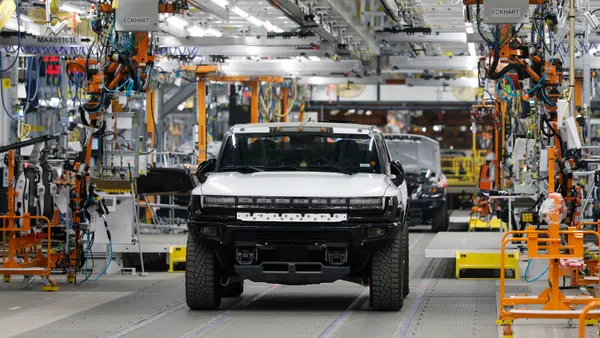Dive Brief:
- Despite a post-election bump, U.S. manufacturers continue to turn offshore rather than boost production in the country, according to A.T. Kearney's fourth annual Reshoring Index.
- Reshoring rose to a five-year high in 2016 as manufacturing jobs returned to the limelight amid a U.S. presidential campaign. But in 2017, the index dropped 27 basis points as imports from the top low-cost trading partners — such as China, Thailand and Vietnam — continued to outpace domestic production.
- In 2017, imports from offshore partners reached $751 billion, with China representing two-thirds of that sum. U.S. domestic output, meanwhile, reached $6 trillion in 2017. The gap led to the highest "manufacturing import ratio" since the first index in 2014, according to the report.
Dive Insight:
A wave of tit-for-tat tariffs is threatening to reshape manufacturing, but exactly how is far from clear.
The Reshoring Index shows that, so far and despite a few blips, the trend has been to import more from low-cost countries than what is produced at home.
"There are several reasons for this ongoing trend away from reshoring, including the continued economic benefits of producing labor-intensive products overseas, the fact that significant offshore investments were made that are not easily abandoned, and the domestic shortage of skilled labor for manufacturing operations," A.T. Kearney wrote in the analysis of its index.
President Donald Trump is hoping to reverse that trend, however, with $34 billion worth of tariffs on Chinese imports, which entered into effect last week.
The tariffs target a wide range of products, from soybeans to semiconductors, according to an analysis from voxEu.org. However, the majority of the taxed products are intermediate and capital goods, used not just by foreign firms, but also domestically.
This, for some like New York Times contributor Paul Krugman, presents a question: Is the U.S. targeting the right goods to bring production back to the nation? In an op-ed, Krugman argues China is targeting finished goods, not components or capital equipment, with its tariffs.
The answer is far from simple. However, the A.T. Kearney data makes it possible to look back at what types of companies are coming back to the U.S.
"The reshoring index does not track or segment Finished Goods from Intermediate Goods and only includes Manufactured Goods, e.g. not agricultural commodities like the ones that are now seeing some China retaliatory tariffs," Patrick Van den Bossche, partner at A.T. Kearney, clarified in an e-mail to Supply Chain Dive.
"The majority of reshoring cases reported in the media are for production of finished goods," he added, providing a table of the top 10 industries represented in the consulting firm's database.
Perhaps in seeing these intermediate and capital goods manufacturing companies return to the U.S., Trump is trying to give them a leg up with an import tax on their products.
However, in general, offshoring "has a higher proportion of finished goods than intermediate goods as final assembly tends to be more labor intensive / less value add than intermediate goods," Van den Bossche wrote. "For example in electronics manufacturing the high value add components are typically made in advanced economies and only assembled in China."
It will take a long time before manufacturing trends from the tariffs become clear. A careful eye on product prices, and what type of companies choose to leave or come back — if any — may provide one indicator. A.T. Kearney's Reshoring Index at least provides a baseline by which to compare, next year.
Top 10 industries with significant reshoring cases
|
Standardized Sector - Industry |
Total Reshoring Cases |
|
Manufacturing - Electrical Equipment, Appliance, & Component Manufacturing |
101 |
|
Manufacturing - Transportation Equipment Manufacturing |
92 |
|
Manufacturing - Apparel Manufacturing |
75 |
|
Manufacturing - Miscellaneous Manufacturing |
71 |
|
Manufacturing - Computer & Electronic Product Manufacturing |
70 |
|
Manufacturing - Plastics & Rubber Products Manufacturing |
56 |
|
Manufacturing - Machinery Manufacturing |
46 |
|
Manufacturing - Fabricated Metal Product Manufacturing |
31 |
|
Manufacturing - Furniture & Related Product Manufacturing |
18 |
|
Manufacturing - Nonmetallic Mineral Product Manufacturing |
17 |
SOURCE: A.T. Kearney Reshoring Index database















